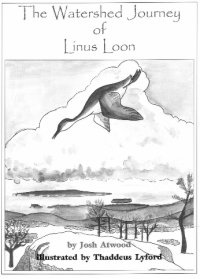
Gulf Voices
The watershed wisdom of Linus Loon and friends
Printer Friendly Page
By Josh Atwood
At one time I would have said “no.” I have come to love the world of Linus Loon and his
unusual friends, but in the early summer of 2003 this world did not yet exist for me. Theresa
Torrent-Ellis, my supervisor at the Maine Coastal Program, had asked me to create an ecological
children's book and had suggested using a loon to tell the story. With a mostly blank schedule
and many blank pages, I headed to my home in Hampden to begin my creative process.
For a while this “creative process” consisted of staring off into space. I sat with my laptop
carefully positioned so as not to fall into the swimming pool in which my legs were dangling. As
unproductive as this seems, staring into space provided me the time to think fundamentally about
environmental education. What attracts us to nature? What drives scientific exploration? After an
intense staring session, I decided that my answer to both was “imagination.”
Writer and conservationist Gerard Durrell described the world as, “a paradise of enigmas.” The
world is a mystery novel without an ending, and as humans it drives us crazy that we can't skip ahead
and read the last page. But therein lies imagination: how, what, when and why? These are the
fundamental questions of science, and no one has a definite answer to any of them. Young students
are full of imagination, and for them the answers to these questions are limitless. Anything becomes
possible, and that is truly exciting.
This is how I decided to nudge my book outside the limits of conventional reality. Luckily I am
not very mature, but rather the sort of person who pretends that his car is actually a spaceship
loaded with torpedoes. Therefore I had no conflict placing factual information about nonpoint source
pollution into the mouths of such uncatalogued species as gnomes and trolls. Fortunately the roles of
exposition and reflection fit well with the natural history of these species:
gnomes are very wise, always writing books about ecology and often giving advice on ecological issues.
In contrast, trolls have very little knowledge about the environment, but remain inquisitive. They are
not stupid, but due to a tragic paper allergy they have not read many books. Thus they are always
hanging around gnomes and asking questions of passersby. It is through these creatures that Linus
Loon is introduced to such concepts as biomagnification, eutrophication, the water cycle,
biodiversity and nonpoint source pollution.
David Sobel, professor at Antioch New England in Keene, New Hampshire, writes that elementary
environmental education should be grounded in appreciation and exploration rather than strict
delivery of scientific fact. This creates a foundation on which environmental knowledge may be
built and more closely matches the developing cognitive abilities of young students. My goal then,
as a writer, was not to make young students experts in eutrophication, but to show them the beauty
and mystery of Maine's watershed ecosystems and introduce a few ecological concepts along the way.
My gnomes and trolls simply facilitated the reader's entry into a world that could be explored
without limits, including exploration of a variety of ecosystems and ecological concepts.
Once I had plotted my course, the rest of my journey as a writer fell into place. Linus went
on to explore a bog, a river, an estuary and finally made it to the ocean. I went on to meet
Thaddeus Lyford, the illustrator, and finally made it to the printers. In the final version,
Thaddeus' watercolors steal the show and perfectly embody the sense of wonder and adventure that
Linus experiences on his journey. Now there are 2,700 copies in circulation, and I can sit back and
enjoy reading the book to my class in Brunswick.
Reading the book to students is enjoyable not because I get to review the science of watershed
ecology, but because I get to see nature from their point of view. As a class we use our
imaginations and ask the questions that adult scientists have stopped asking: How is gum on the
playground an example of nonpoint source pollution? Could the water we drank this morning have
been dinosaur saliva at one time? Are there really gnomes? Scientists will tell you that we know
nothing with absolute certainty, and so I say that of course there could be gnomes. For all we know
they do exist, and for years they may continue to make glad the heart of environmental education.
Copies of The Watershed Journey of Linus Loon are available free to educators by contacting
the Maine Coastal Program at 207-287-1486. It is available to the public at www.maine.gov/spo/mcp.
Josh Atwood works for the Maine Coastal Program at the State Planning Office in Augusta. As an
Americorps Environmental Educator, he founded “Recycled Knowledge,” an eco-mentoring program for
high school and elementary school students.
By David Sobel:
Beyond Ecophobia: Reclaiming the Heart in Nature Education
To find out more about the many contributions of Gerald Durrell (1925-1995) to worldwide wildlife
conservation go to:
www.durrellwildlife.org.

 EACH WEEK OF LATE I get to read a chapter from The Watershed Journey of Linus Loon to a fourth grade
class in Brunswick, Maine. The book, which I wrote in the summer of 2003 for the Maine Coastal
Program, tells the story of Linus Loon, who must migrate to the ocean by swimming through the
watershed due to an injured wing. Along the way, he meets wise gnomes and inquisitive trolls that
discuss concepts of watershed ecology and nonpoint source pollution. On the day that I read the
first chapter to my students, a young girl approached me at the end of our session and got my
attention by tugging my shirtsleeve. “Excuse me,” she said, “but are there really gnomes?”
EACH WEEK OF LATE I get to read a chapter from The Watershed Journey of Linus Loon to a fourth grade
class in Brunswick, Maine. The book, which I wrote in the summer of 2003 for the Maine Coastal
Program, tells the story of Linus Loon, who must migrate to the ocean by swimming through the
watershed due to an injured wing. Along the way, he meets wise gnomes and inquisitive trolls that
discuss concepts of watershed ecology and nonpoint source pollution. On the day that I read the
first chapter to my students, a young girl approached me at the end of our session and got my
attention by tugging my shirtsleeve. “Excuse me,” she said, “but are there really gnomes?”
Books and authors mentioned in this article:
Place-Based Education: Connecting Classrooms & Community;
(each $8 at www.oriononline.org).